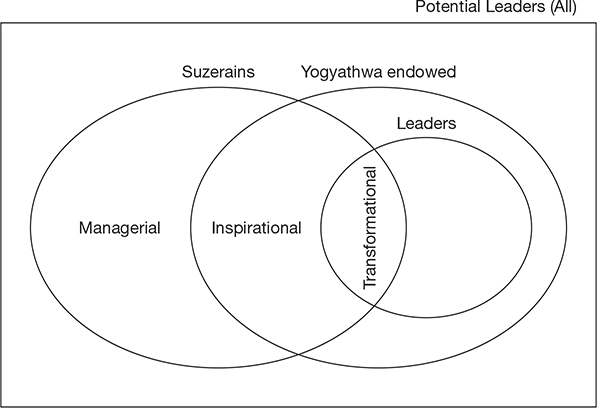CHAPTER 21
The Suzerainty and Leadership Matrix: Understanding were We Stand
CHAPTER OBJECTIVES
After studying this chapter, you should be able to:
- Know the components of the Suzerainty and Leadership matrix.
- Mark out areas in the matrix which indicate tendencies of personalities.
- Make a self analysis of one’s own position and become aware of the optimal direction for self improvement.
A Map to Track Leadership Journeys
It is useful to take a map along when traveling because by doing this, (a) use is made of the experience of people who have travelled earlier; (b) it prevents the repeat of unnecessary mistakes and (c) it increases the chances of pushing the pioneering frontiers of discovery even farther. When a person is similarly on a journey towards leadership he must capitalize on the experience of those who went before him.
In this chapter, we shall try to come up with one such map on leadership. It is a matrix which resolves the various aspects of leadership in a simple way as possible. Shorn of complexity it should help the student/reader to get a fair comprehension of the field and help him take decisions on how to go about achieving what he wishes to.
The Suzerainty-Leadership Matrix
We have seen how those who get to become suzerains may not be truly leaders as they could be missing the trait of Yogyathwa. Similarly, it is quite possible that a person is a leader and he is not a recognized suzerain. Now there are a whole lot of permutations and combinations. The following diagrams will help resolve the various possibilities.
A point on the matrix would indicate what a particular individual’s attitude is at a given instant of time. An area in the matrix could plot the general tendency of any particular leader/suzerain.

The terms in the diagram mean the following:
Potential Leaders All humans are potential leaders because they all have the supreme-self driving them from within.
Yogyathwa Endowed Out of the total number of humans there are some who are habitual in practicing yogas which they may have picked up as they grew up; or they may have learnt it from teachers. They have intermittent access to the ‘voice of the supreme self’ owing to their disciplined practices …
Leaders A few amongst the Yogyathwa endowed have intimate access to the ‘voice of the supreme self’; convinced by either a gut or by the knowledge-experience combination of the truth about a higher dimension they actively seek to be obedient to it.
Suzerains Some of the people get designated as suzerains. Now these suzerains could be of all three kinds, those not endowed with Yogyathwa, only Yogyathwa endowed and leaders. Therefore, we have three categories of suzerains arising from this classification: managing suzerains, inspirational suzerains and transformational leader-suzerains respectively.
Negative Suzerains In the diagram in the next page we have an additional subset from amongst the suzerains—those who impact society negatively. They can be of two types: the yogic types and the non-yogic types. While negative suzerains with no inspirational abilities can be a headache to organizations and people in general, it is the negative suzerains who have the ability to inspire who can end up creating disaster.
The supreme is present in everyone in equal measure. The powers that are within human beings are accessible to everyone. It is through yoga that one gains access to this higher potential. It is therefore possible that there are some people who, through high discipline, through following yogas which they learnt in their younger years, are able to bring out high class performances at crucial moments. Through rigors that they underwent in younger years they are capable of being completely aware of the present moment and are therefore able to grab the opportunities that come to them. Through the disciplines they have learnt they become efficient in management of men and resources. Such people are therefore (1) high on performance and (2) in that performance they can also inspire.

The negative part though lies in the fact that they are ignorant of their highest nature they are therefore focused on the aspirations and desires of their ‘individual’ natures. They therefore harbour aims that cater not to dharma’ but to the opposite of it, ‘a-dharma’ … that is, they cater to individual whims, fancies and desires and this combination can lead to such ‘negative leaders’ if one may … .
Also note that this is not a static picture. That is, an individual cannot be indicated by a point on this picture. It is possible for people to shift their positions from time to time … this is why it is said that it is wrong to designate someone as bad or good … only actions are either bad or good. An act by a leader can be indicated at a point though. Therefore, we can only speak in terms of tendencies. This picture holds for ‘tendencies’ more precisely than for ‘fixed natures’. In fact an area can be marked out for each person indicating the general areas in which he has operated.
It is wrong to designate someone as good or bad. However actions can be good or bad. In the over all picture we can surely talk about tendencies by marking out areas.
Also, it would also be apt if we could draw a lot of concentric ellipses ranging from within the leader ellipse to just within the Yogyathwa ellipse. The point being made is that we can make further categorizations in respect of the levels of Yogyathwa and understanding and say that as one increasingly moves into the smaller ellipses when his leadership abilities rise. One such is taken up in Appendix C.
As an exercise let us compare the styles of two of India’s leaders who had a significant impact on the Indian struggle and the partition of India.
Mohammad Ali Jinnah
He was an outstanding lawyer. His yogic abilities and disciplines, that were nurtured in him by his family and his upbringing, helped him to establish himself as influential amongst the group he went on to represent. He had no overbearing love for religion and therefore his practice of yoga was limited; in fact he did not practice even the basic austerities that were recommended for him in his own religion. Unlike Gandhiji he took to suzerainty. He stood for elections and went on to take up positions of authority in the new found Pakistan. Another feature that distinguished him from Gandhi was that he truly did not indicate belief in the Common Soul enough to either endeavour towards it nor to understand the subtle oneness of man. His secularism projected a warm thought of rightful nation-building so as to accommodate people from other perspectives too in his fold but this was not grounded in faith in the Common Soul. His aims of creating a secular nation did not carry much weight possibly because it lacked the conviction of a practicing yogi and a knower of the Common Soul. Another important feature of his suzerainty was that his efforts were guided by the strengthening of divisive identity rather than weakening of it. He therefore found it difficult striking a proper balance between a selfless ethos that was needed to set up a new nation and a selfish ethos which was needed to divide a larger nation in order to create a new one. His efforts therefore put him in an area that makes him jump across the line separating positive and negative leaders who have yogic abilities.
His manner of moving people was on the basis of their fears and worries. He used the influence of religion to herd his flock together. His mannerisms definitely inspired followers but this limited group was not the kind who followed the heart but rather more like the ones who follow the alpha male. Needless to say, he had an intimidating presence arising from his groomed yogic abilities and it was awe-inspiring.
Mahatma Gandhi
Mahatma Gandhi is sometimes even referred to as a saint and his methods, though effective, are hard to understand. He also did not hide the fact that he would let his ‘inner voice’ speak and he took decisions on that behalf—There is a high likelihood that this refers to the Common Soul.
While many of his austere tendencies were apparent in his early years, he truly flowered only when his yogic nature emerged after a lot of personal struggle. He had once stood in front of a judge frozen, unable to rattle out the speech he had so carefully written. And yet he went on to lead a nation in his own style and through great conviction. He nurtured his strong sense of austerity which in turn helped him develop the yogic strength to stick to his convictions.
Another remarkable thing he did was that he kept himself away from suzerainty. However, as a leader he did influence suzerains and commoners alike. An important feature of Gandhiji’s leadership was that the austerities he practiced, inspired many people to follow. Be it the spinning of Khadi, the rejection of foreign goods, the practice of satyagraha—people even laid down their lives in this cause. This rather uncommon attribute indicated that he had the ability to make leaders out of common men. A study of the principle of satyagraha which we have done in Chapter 7 of the book indicates that he had the ability to make people feel a high sense of self-worth and make them stand up to the full height of their spiritual natures.

The above diagram shows where the two leaders can be placed. The arrows indicate the general movement of the leaders as they progressed in their public activities. While in the case of MK Gandhi it was towards the higher spheres of Yogyathwa and self-discovery, in the case of MA Jinnah he maintained status quo and did display an oscillation between a self-centred and selfless approach.
Case Studies
- Pick up the personality profile of any suzerain and try to analyse this position in the leadership-suzerainty matrix.
- Consider the activities taken up by an organization towards the betterment of its members; one may also include practices and traditions relating to interaction at all levels. Analyse as to the direction in which these activities tend to move the members on the matrix.
- Consider a particular case of a problem child or a problem employee. Analyse the position of the person on the leadership-suzerainty matrix. Based on this analysis recommend a course of corrective action.
Exercises
- Self-analysis: Locate one’s own position in the matrix. Find out the general nature of movement in due course of time. Enlist the influences that make you move in the desirable direction.
- Discussion: Take examples of personalities having undergone life changing transformations. Indicate the corresponding changes in the leadership-suzerainty matrix. Therefore, discuss the changes that take place at each boundary.
- Distribute the case study of a given personality in class. Break them up into groups and provide each group with a worksheet containing the leadership-suzerainty matrix. Ask them to plot the personality profile of the leader on the matrix based on group discussions … ask teams to give brief presentations with justification about why they plotted the profile the way they did. Discuss subjectivity and objectivity.
